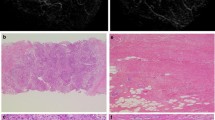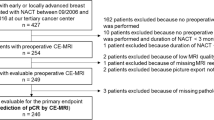Abstract
Purpose. To investigate whether magnetic resonance imaging (MRI) is superior to clinical palpation in the assessment of response of breast cancer to primary chemotherapy (PC).
Patients and methods. Seventy-three patients with T2–4, N0, M0 breast cancer were treated with 3–4 cycles of single agent epirubicin before definitive surgery. MRI was performed at baseline condition and at the end of chemotherapy.
Results. According to the WHO criteria, 20 (27.4%) patients attained a complete response (CR) by clinical palpation and 41 (56.2%) a partial response. The corresponding response rate by MRI was 11 (15.1%) and 34 (46.6%), respectively. Residual tumor assessed by MRI better correlated with pathologic measurements (Spearman r: 0.72) than residual tumor assessed by clinical palpation (Spearman r: 0.58). Post-chemotherapy histology evaluation revealed pathologic CR in three cases, only one of them was considered as complete responder by MRI. Residual disease consisted in in situ carcinoma in four cases, one of them was complete responder at MRI, the remaining three showed residual abnormal contrast enhancement indistinguishable from that of invasive tumors.
Conclusions. As compared to pathology specimens, MRI is able to represent the extent of cancer more accurately than clinical palpation. It constitutes a promising technique in assessing the BC response to PC. The current limit of MRI is the scarce specificity in predicting the nature of residual disease.
Similar content being viewed by others
References
Bonadonna G, Veronesi U, Brambilla C, Ferrari L, Luini A, Greco M, Bartoli C, Coopmans de Y, Zucali R, Rilke F, Andreola S, Silvestrini R, Di Fronzo G, Valagussa P: Primary chemotherapy to avoid mastectomy in tumors with diameter of three centimetres and more. J Natl Cancer Inst 82: 1539–1545, 1990
Fisher B, Bryant J, Wolmark N, Mamounas E, Brown A, Fisher ER, Wickerham DL, Begovic M, DeCillis A, Robidoux A, Margolese RG, Cruz Jr AB, Hoehn JL, Lees AW, Dimitrov NV, Bear HD: Effect of preoperative chemotherapy on the outcome of women with operable breast cancer. J Clin Oncol 16: 2672–2685, 1998
Mamounas EP, Fisher B: Preoperative (neoadjuvant) chemotherapy in patients with breast cancer. Semin Oncol 28: 389–399, 2001
Bonadonna G, Valagussa P, Brambilla C, Ferrari L, Molinterni A, Terenziani M, Zambetti M: Primary chemotherapy in operable breast cancer: eight years experience at the Milan Cancer Institute. J Clin Oncol 16: 93–100, 1998
Fisher B, Mamounas EP: Preoperative chemotherapy: a model for studying the biology and therapy of primary breast cancer. J Clin Oncol 13: 537–540, 1995
Aapro M: Neoadjuvant therapy in breast cancer: can we define its role? Oncologist 6(Suppl 3): 36–39, 2001
Bottini A, Berruti A, Bersiga A, Brizzi MP, Brunelli A, Gorzegno G, DiMarco B, Aguggini S, Bolsi G, Cirillo F, Filippini L, Betri E, Bertoli G, Alquati P, Dogliotti L: p53 but not bcl2 immunostaining is predictive of poor clinical complete response to primary chemotherapy in breast cancer patients. Clin Cancer Res 6: 2751–2758, 2000
Bottini A, Berruti A, Bersiga A, Brizzi MP, Bruzzi P, Aguggini S, Brunelli A, Bolsi G, Allevi G, Generali D, Betri E, Bertoli G, Alquati P, Dogliotti L: Relationship between tumor shrinkage and reduction in Ki67 expression after primary chemotherapy in human breast cancer. Br J Cancer 85: 1106–1112, 2001
Cocconi G, DiBlasio B, Alberti G, Bisagni G, Botti E, Peracchia G: Problems in evaluating response of primary breast cancer to systemic therapy. Breast Cancer Res Treat 4: 309–313, 1984
Jockelson M: Breast cancer imaging: the future. Semin Oncol 28: 221–228, 2001
Nistrom L: Breast cancer screening with mammography: overview of Swedish randomized trials. Lancet 341: 973–978, 1993
Fiorentino C, Berruti A, Bottini A, Bodini M, Brizzi MP, Brunelli A, Marini U, Allevi G, Aguggini S, Tira A, Alquati P, Olivetti L, Dogliotti L: Accuracy of mammography and echography versus clinical palpation in the assessment of response to primary chemotherapy in breast cancer patients with operable disease. Breast Cancer Res Treat 69: 143–151, 2001
Trecate G, Tess JD, Vergnaghi D, Bergonzi S, De Simone T, Mariani G, Musumeci R: Breast microcalcifications studied with 3D contrast enhanced high-field magnetic resonance imaging: more accuracy in the diagnosis of breast cancer. Tumori 88: 224–233, 2002
Stoutjesdijk MJ, Boetes C, Jager GJ, Beex L, Bult P, Hendriks JH, Laheij RJ, Massuger L, van Die LE, Wobbes T, Barentsz JO: Magnetic resonance imaging and mammography in women with a hereditary risk of breast cancer. J Natl Cancer Inst 93: 1095–1102, 2001
Khatri VP, Stuppino JJ, Espinosa MH, Pollack MS: Improved accuracy in differentiating malignant from benign mammographic abnormalities. Cancer 92: 471–178, 2001
Stomper PC, Winston JS, Herman S, Klippenstein DL, Arredondo MA, Blumenson LE: Angiogenesis and dynamic MR imaging gadolinium enhancement of malignant and benign lesions. Breast Cancer Res Treat 45: 39–46, 1997
Miller AB, Hoogstroten B, Staquet M, Winkler A: Reporting results of cancer treatment. Cancer 47: 207–214, 1981
Gilles R, Guinebretière JM, Troussaint C, Spielman M, Rietjens M, Petit JY, Contesso G, Masselot J, Vanel D: Locally advanced breast cancer: contrast-enhanced subtraction MR imaging of response to preoperative chemotherapy. Radiology, 191: 633–638, 1994
Abraham DC, Jones RC, Jones SE, Cheek JH, Peters GN, Knox SM, Grant MD, Hampe DW, Savino DA, Harms SE: Evaluation of neoadjuvant chemotherapeutic response of locally advanced breast cancer by magnetic resonance imaging. Cancer 78: 91–100, 1996
Rieber A, Zeitler H, Rosenthal H, Gorich J, Kreienberg R, Brambs HJ, Tomczak R: MRI of breast cancer: influence of chemotherapy on sensitivity. Br J Radiol 70: 234–239, 1997
Trecate G, Ceglia E, Stabile F, Tesoro-Tess JD, Mariani G, Zambetti M, Musumeci R: Locally advanced breast cancer treated with primary chemotherapy: comparison between magnetic resonance imaging and pathologic evaluation of residual disease. Tumori 85: 220–228, 1999
Esserman L, Kaplan E, Partridge S, Tripathy D, Rugo H, Park J, Hwang S, Kuere H, Sudilovsky D, Lu Y, Hylton N: MRI phenotype is associated with response to doxorubicin and cyclophosphamide neoadjuvant chemotherapy in stage III breast cancer. Ann Surg Oncol 8: 549–559, 2001
Weatherall PT, Evans GF, Metzger G, Saborrian MH, Leitch AM: MRI vs histologic measurement of breast cancer following chemotherapy: comparison with x-ray mammography and palpation. J Magn Reson Imaging 13: 868–875, 2001
Davis PL, Staiger MJ, Harris KB, Ganott MA, Klementaviciene J, McCarty Jr KS, Tobon H: Breast cancer measurements with magnetic resonance imaging, ultrasonography, and mammography. Breast Cancer Res Treat 37: 1–9, 1996
Kinkel K, Hylton NM: Challenges to interpretation of breast MRI. J Magn Reson Imaging 13: 821–829, 2001
Esserman L, Wolverton D, Hylton N: Magnetic resonance imaging for primary breast cancer management: current role and new applications. Endocrine-Related Cancer 9: 141–153, 2002
Frei KA, Kinkel K, Bonel HM, Lu Y, Esserman LJ, Hylton NM: MR imaging of the breast in patients with positive margins after lumpectomy: influence of the time interval between lumpectomy and MRI imaging. Am J Roentgenol 175: 1577–1584, 2000
Mankoff DA, Dunnwald LK, Gralow JR, Ellis GK, Charlop A, Lawton TJ, Schubert EK, Tseng J, Livingston RB: Blood flow and metabolism in locally advanced breast cancer: relationship to response to therapy. J Nucl Med 43: 500–509, 2002
Author information
Authors and Affiliations
Rights and permissions
About this article
Cite this article
Bodini, M., Berruti, A., Bottini, A. et al. Magnetic Resonance Imaging in Comparison to Clinical Palpation in Assessing the Response of Breast Cancer to Epirubicin Primary Chemotherapy. Breast Cancer Res Treat 85, 211–218 (2004). https://doi.org/10.1023/B:BREA.0000025409.69516.23
Issue Date:
DOI: https://doi.org/10.1023/B:BREA.0000025409.69516.23




